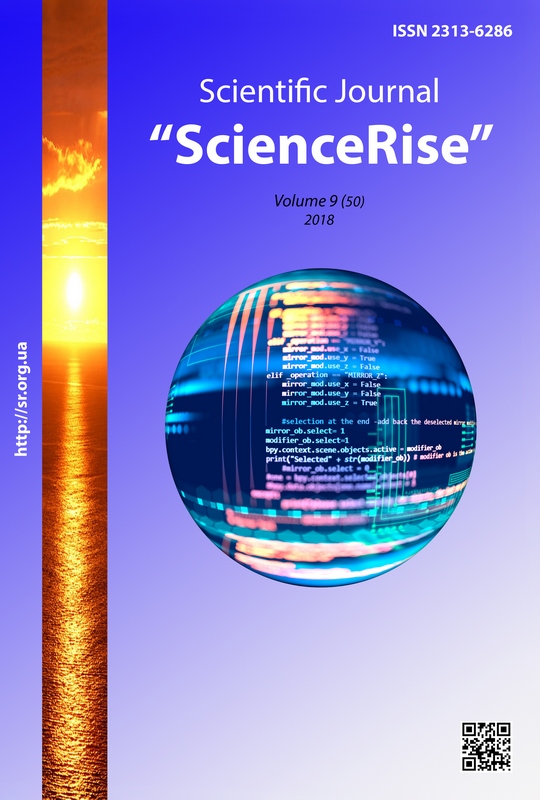Mathematical modeling of biogas lifting from the municipal solid waste polygon
DOI:
https://doi.org/10.15587/2313-8416.2018.143412Keywords:
biogas, mathematical model, municipal solid waste polygon, heated gas formationsAbstract
The mathematical model specified height and time dependence of the center movement speed, proper size (radius), excess relative temperature, buoyancy of heated gas formations (biogas) with convective rise in atmospheric air above the municipal solid waste polygon has been developed in the paper. The numerical estimates of changes in the main parameters of heated gas formations for proper situations from the municipal solid waste polygon have been provided
References
Arhipova, G. I., Galushka, Y. O. (2009). Impact of household waste dumps on human health. Scientific bulletin NAU, 3, 217–219.
Dmitruk, O. O., Dmitruk, E. A. (2017). Physico-chemical essence of the formation process of landfill gas from municipal solid waste polygon. Digest of scientific works of NGU, 52, 335–341.
Popovich, V. V. (2012). Fire hazard of spontaneous landfills and municipal solid waste polygons. Fire hazard: digest of scientific works, 21, 140–147.
Analytical report on fire and its impact in Ukraine for 8 months of 2018 (2018). Ukrainian Research Institute of Civil Protection, 18.
Brushlinsky, N. N., Ahrens, M., Sokolov, S. V., Wagner, P. (2017). World Fire Statistics. International Association of Fire and Rescue Service, 56.
Shaimova, A. M., Nasirova, L. A., Yagafarova, G. G., Ilina, E. G., Fashutdinov, R. R. (2009). Development of mathematical model of biogas formation from municipal solid waste polygons. Oil and gas business, 7, 137–140.
Kamalan, H., Sabour, M., Shariatmad, N. (2011). A Review on Available Landfill Gas Models. Journal of Environmental Science and Technology, 4 (2), 79–92. doi: https://doi.org/10.3923/jest.2011.79.92
Figueroa, V. K., Cooper, C. D., Mackie, K. R. (2010). Estimating Landfill Greenhouse Gas Emissions from Measured Ambient Methane Concentrations and Dispersion Modeling. Tallahassee: Department of Civil and Environmental Engineering, University of Central Florida, 17.
Bilchedey, T. K. (2011). Modeling of biogas components transport and dispersion in the ambient air from the municipal solid waste polygons. Bulletin of RUDN. Series: Ecology and life safety, 1, 49–52.
Osipova, T. A., Remez, N. S. (2015). Prediction of biogas output and municipal solid waste polygon temperature on the basis of mathematical modeling. Bulletin of Michael Ostrogradsky KrNU, 3, 144–149.
Gostintsev, Yu. A., Shackih, Yu. V. (1987). On the generation mechanism of long-wave acoustic perturbations in the atmosphere by a pop-up cloud of explosion products. Physics of combustion and explosion, 2, 91–97.
Downloads
Published
Issue
Section
License
Copyright (c) 2018 Nina Rashkevich, Igor Goncharenko, Liudmula Anishenko, Leonid Pisnya, Serhii Petrukhin, Elena Serikova

This work is licensed under a Creative Commons Attribution 4.0 International License.
Our journal abides by the Creative Commons CC BY copyright rights and permissions for open access journals.
Authors, who are published in this journal, agree to the following conditions:
1. The authors reserve the right to authorship of the work and pass the first publication right of this work to the journal under the terms of a Creative Commons CC BY, which allows others to freely distribute the published research with the obligatory reference to the authors of the original work and the first publication of the work in this journal.
2. The authors have the right to conclude separate supplement agreements that relate to non-exclusive work distribution in the form in which it has been published by the journal (for example, to upload the work to the online storage of the journal or publish it as part of a monograph), provided that the reference to the first publication of the work in this journal is included.

